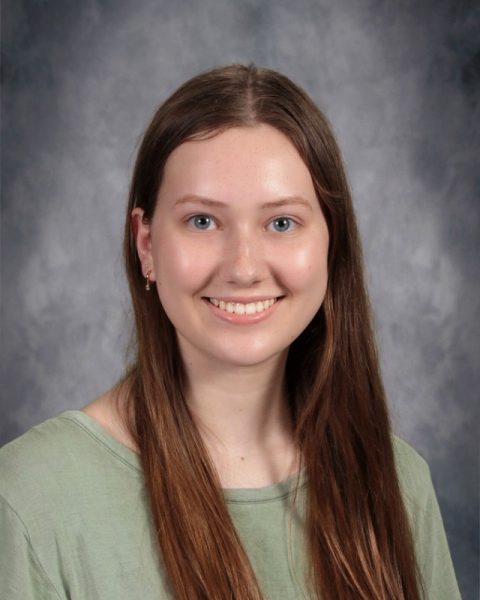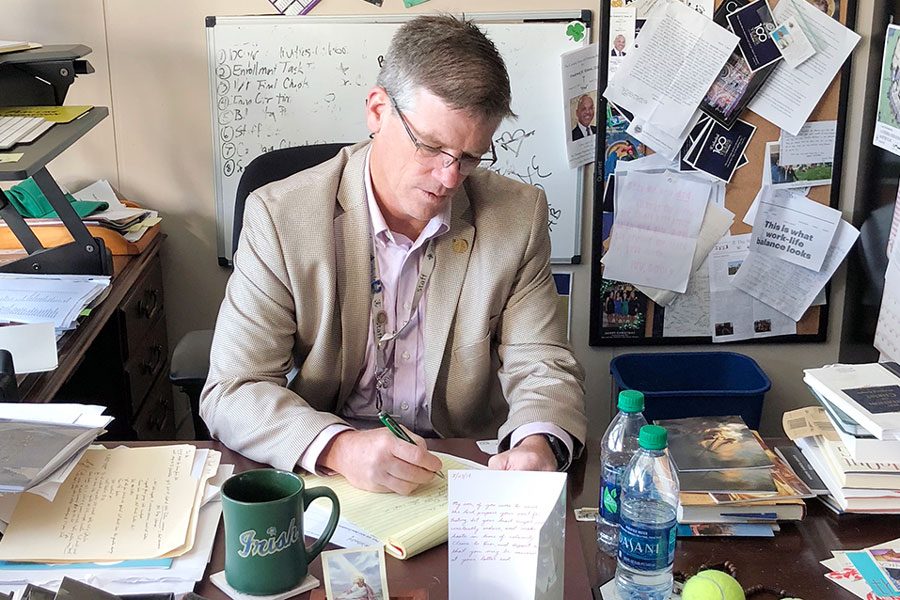Administration to implement five-year plan
Focus will be on 12 specific areas on campus
President Dr. Robert Bridges works at his desk in Kelly Hall.
The school’s leaders have formulated a five-year plan they hope will result in an innovative and multifaceted school.
This plan will touch on many aspects of a student’s education and experience on the Hill, including academics, athletics, the arts, technology, religion and diversity and inclusivity.
School President Dr. Robert Bridges will supervise this plan. He said, “The mission is to educate a diverse group of students to have the competence to see and the courage to act. The vision is to be the Catholic school of the future.” He hopes this plan will accomplish that.
This plan has been in the works for about three years, when the Independent Schools Association of the Central States reviewed the school and gave Bridges a full report of their findings. While the school was accredited, the inspectors didn’t find any evidence of the school’s mission statement to be, as it claimed, “the Catholic school of the future.”
Bridges said, “I scratched my head about that for a couple weeks and thought, how could we become the Catholic school of the future? So I looked around the school and started thinking about some things we could do differently.”
Plans for the Innovation Center were already in progress, so Bridges decided to take it a step further. Over the past couple years, he’s merged departments, updated teaching methods and changed department names, all the while collecting feedback from both students and educators. This data ended up forming the basis of the five-year plan.
Future projects include constructing Johnny Mac’s Coffeehouse in the Shiel Student Life Center, raising and spending millions of dollars updating and expanding Brunette Park, refurbishing the theater and enhancing the arts program.
The plan will focus on 12 areas: Academics, the arts, athletics, student life, Catholic identity and Holy Cross formation, inclusive and diversity, professional development and growth, facilities, technology, marketing and enrollment, advancement and finance.
An educator or administrator from each of these departments has formed a team and received input on how to improve that area. The team drafted a plan that was presented to the school’s board of trustees and then was revised and presented again. Every quarter, each team updates their progress and adjusts their plans accordingly.
Bridges said, “Normally schools will hire a fancy consultant to direct a five-year plan and pay them thousands of dollars. But we’re trying to think like the Catholic school of the future. So I asked the board chair, is it OK if we take the people we already pay, give them ownership and let them lead this project?”
Blending tradition with innovation can be a daunting task. However, Bridges believes that by incorporating existing traditions, the school can move forward while still maintaining religious roots. He said, “We have great traditions like the Irish blessing and Irish 500. Keeping our traditions and being the Catholic school of the future is a trick, but we (can) do it. We blend the traditions, but we also try to look forward because we want people to choose (Cathedral) when they have a choice.”
And they have. The school made history with one of the largest Freshman Classes this school year, consisting of 288 students from 73 different schools. Bridges attributes this to the school’s management of Covid-19 and its ability to stay open and provide in-person instruction for most of the last school year.
While Bridges is appreciative of this enrollment, he still wants to keep each class size relatively small. Bridges said, “(Around) 280 to 300 students is a good size for us. I don’t think we could take 500 freshmen next year. We’d be too crowded. We don’t want to be like some of the larger (high) schools north of us that have thousands of kids, because then I wouldn’t personally know individual families.”
On a final note regarding how the plan will be implemented, Bridges said, “Schools are not famous for change. Teachers are not famous for change. But when (two ISAACS representatives) sat in my office and told me that we needed to sync it up, it gave me a little push to try doing things differently. I think it’s extra special when schools do embrace change. If you’re going to be a great organization, you have to know where you’re going.”
And for Bridges, the five-year plan will do exactly that.

Olivia Uskert is a senior reporter for the Irish Connection Media Network. She is interested in telling stories about Cathedral’s performing arts programs,...







